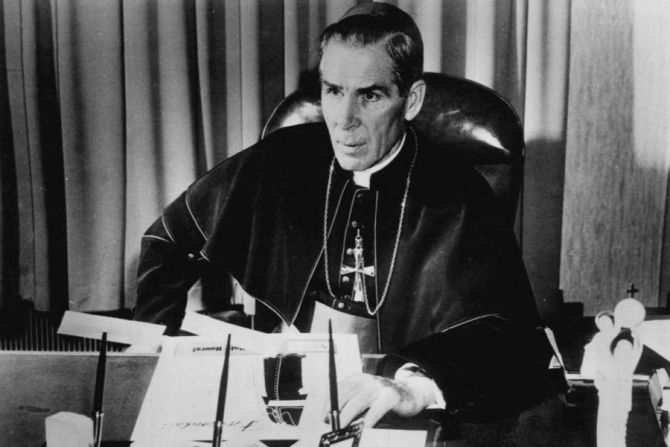New York City, N.Y., Jun 15, 2018 / 11:21 am
The Archdiocese of New York announced on Friday that the Trustees of St. Patrick's Cathedral are appealing a court decision that would allow Venerable Archbishop Fulton Sheen's body to be moved to Peoria, Ill., as his cause for beatification proceeds.
The Trustees, who oversee archdiocesan seminaries, "believe that the recent court case concerning the earthly remains of Venerable Archbishop Fulton J. Sheen was again incorrectly decided, and will seek an appeal of that decision along with a stay on moving the remains while the appellate court considers the case," said a June 15 statement.
"At issue in the case, as the appellate court noted in its reversal of the trial court's original decision, is what were Archbishop's Sheen's personal wishes concerning his final resting place," the statement said.
"As Trustees, it is our responsibility to respect those wishes, and we believe that this most recent decision once again fails to consider those wishes and instead relies on the speculation and conjecture of others."
Last week, the Superior Court of New York ruled in favor of Joan Sheen Cunningham, who had petitioned to move the body of her uncle, Venerable Fulton Sheen, to the Cathedral of St. Mary in Peoria. The body of the late archbishop is currently in St. Patrick's Cathedral in New York City.
Judge Arlene Bluth, ruled that "the location of Archbishop Sheen's final resting place would not have been his primary concern" and that "it makes no sense, given his lifelong devotion to the Catholic Church, that he would choose a location over the chance to become a saint."
The Peoria diocese opened the cause for Sheen's canonization in 2002 after Archdiocese of New York said it would not explore the case. In 2012, Benedict XVI recognized the heroic virtues of the archbishop.
However, Bishop Daniel Jenky of Peoria suspended the beatification cause in September 2014 on the grounds that the Holy See expected Sheen's remains to be in the Peoria diocese.
The Archdiocese of New York, however, has said that Vatican officials have said the Peoria diocese can pursue Sheen's canonization regardless of whether his body is at rest there.
Sheen was born in Illinois in 1895, and was ordained a priest of the Diocese of Peoria at the age of 24. He was appointed auxiliary bishop of New York in 1951, and he remained there until his appointment as Bishop of Rochester in 1966. He retired in 1969 and moved back to New York City until his death in 1979.
Sheen's will had declared his wish to be buried in the Archdiocese of New York Calvary Cemetery. Soon after Sheen died, Cardinal Terence Cooke of New York asked Cunningham, Sheen's closest living relative, if his remains could be placed in the New York cathedral's crypt, and she consented.
Cunningham has said that Sheen would have wanted to have been interred in Peoria if he knew that he would be considered for sainthood. In 2016, she filed a legal complaint seeking to have her uncle's remains moved to Peoria.
An initial court ruling had sided with Cunningham, but a state appeals court overturned that ruling, saying it had failed to give sufficient attention to a sworn statement from a colleague of Archbishop Sheen, Monsignor Hilary C. Franco, a witness for the New York archdiocese.
Msgr. Franco had said that Sheen told him he wanted to be buried in New York and that Cardinal Cooke had offered him a space in the crypt of St. Patrick's Cathedral.
The appeals court ordered "a full exploration" of the archbishop's desires.
In the New York Superior Court decision, Bluth ruled that "Mrs. Cunningham has offered a sound reason and a laudable purpose for her petition" and that Sheen "would care much less about the location of his earthly remains than his ability … to continue to serve man and God on a grand scale after his earthly demise."
(Story continues below)
Both the Diocese of Peoria and the Archdiocese of New York have voiced prayers that the beatification cause may move forward in a timely manner.
Archbishop Sheen served as host of the "Catholic Hour" radio show and the television show "Life is Worth Living".
In addition to his pioneering radio and television shows, Sheen authored many books, with proceeds supporting foreign missions. He headed the Society for the Propagation of the Faith at one point in his life, and continued to be a leading figure in U.S. Catholicism until his death.
Archbishop Sheen's intercession is credited with the miraculous recovery of a pronounced stillborn American baby from the Peoria area.
In June 2014, a panel of theologians that advises the Congregation for the Causes of Saints ruled that the baby's recovery was miraculous.
The baby, later named James Fulton Engstrom, was born in September 2010 showing no signs of life. As medical professionals tried to revive him, his parents prayed for his recovery through the intercession of Fulton Sheen.
Although the baby showed no pulse for an hour after his birth, his heart started beating again and he escaped serious medical problems.


